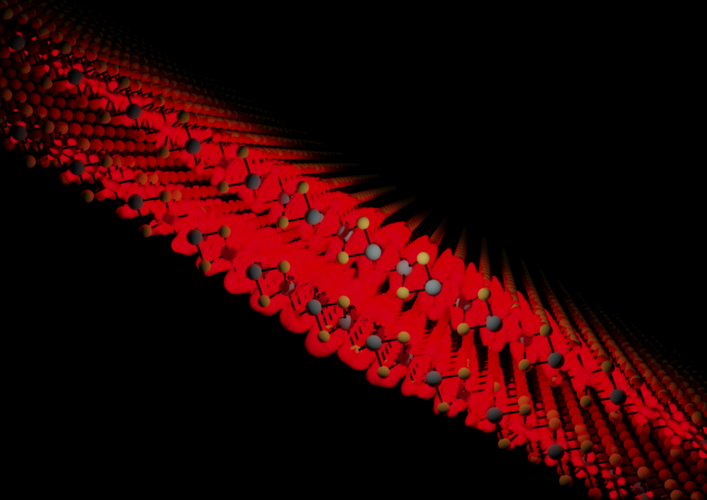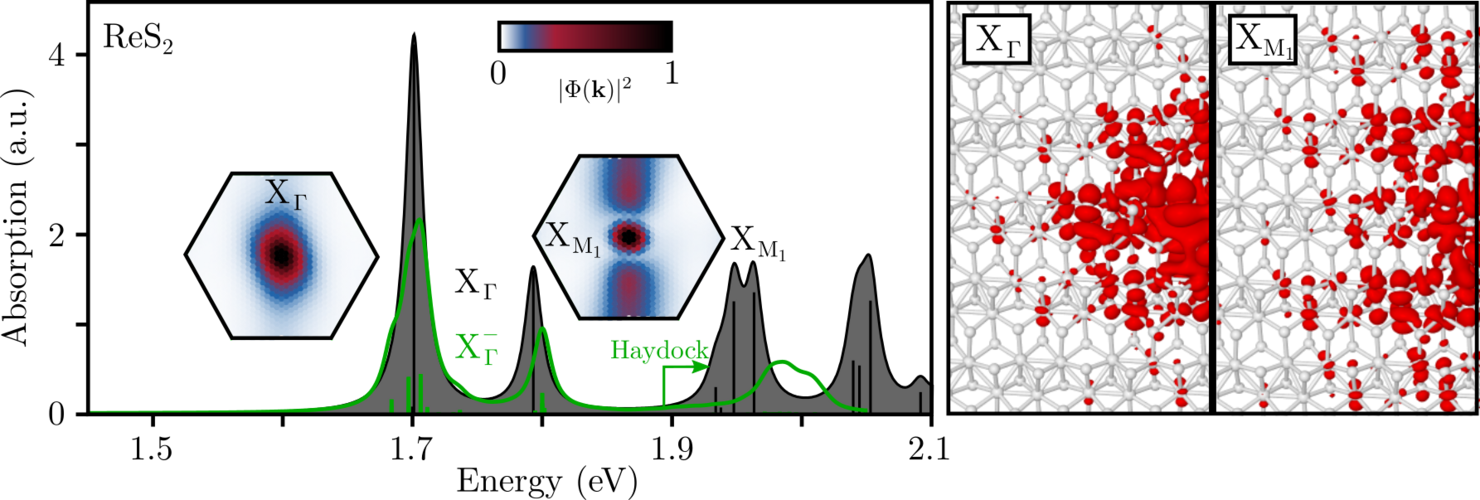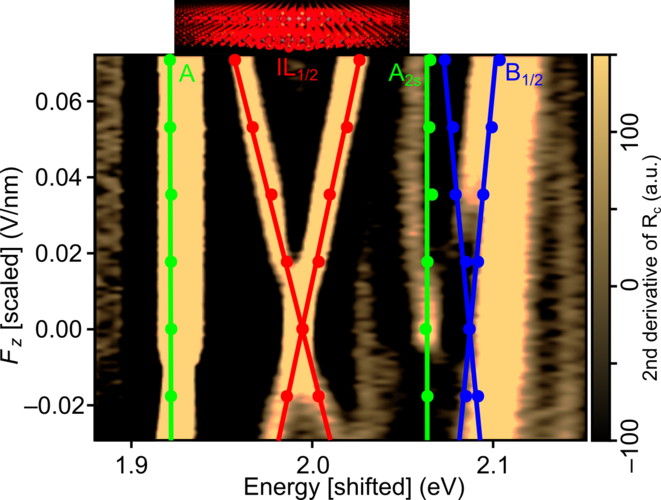MATERIALS SCIENCE AND CHEMISTRY
Optical Properties of Doped Semiconductors
Principal Investigator:
Dr. Thorsten Deilmann
Affiliation:
Universität Münster, Germany
Local Project ID:
trions1
HPC Platform used:
JUWELS CPU of JSC
Date published:
The efficiency of any opto-electronic device, such as a solar cell, light emitting diode, or photodetector, is intrinsically linked to the nature of the electronic quantum states of the photoactive material. For a deeper understanding and targeted development of new devices, an improved theoretical description of bound electronic excitations, i.e., excitons and trions, is crucial.

OPTICAL PROPERTIES
In this project, the optical properties of various promising candidate materials has been analysed. ReS2, a less-frequently studied transition metal dichalcogenide, was one of our focuses. It appears in the 1T' phase, characterised by a significantly reduced symmetry when compared to more common materials like MoS2. Despite preserving inversion symmetry, several broad peaks have been observed in previous experimental measurements. The interpretation of their physical origin and properties is a challenging task without theoretical guidance. To investigate the optical properties of neutral and charged monolayers, ab-initio GW-Bethe-Salpeter equation calculations have been employed. Our detailed analysis of low-energy excitons and trions is presented in Figure 1.

Fig. 1: Absorption of monolayer ReS2 from excitons (grey) and trions (green). Close to the corresponding peaks, the extension in reciprocal is shown, as well as real space wave functions aside [1].
In agreement with experiments, the calculations find that neutral excitons are strongly bound. However, the trion binding energy is remarkably small, at less than 10 meV. Two optically active low-energy excitons have been found, both stem from transitions between the same valence and conduction bands. They represent a direct manifestation of spin-orbit coupling's impact on optical properties. The corresponding exciton amplitude in the first Brillouin zone is shown above, highlighting areas with the highest intensities in red-black. These insets confirm the assignment while revealing the asymmetrical shape near Γ and demonstrating distinct differences in their real space extensions.
Another significant discovery involves interlayer excitons. Interlayer excitons are many-body states arising from the excitation of an electron-hole pair but, in contrast to “normal” excitations, both particles are separated in different spatial regions. A bilayer of MoS have been examined, sharing many characteristics with its 2D monolayer counterpart and offering potential for forming interlayer states. In collaboration with experimental partners [2], These interlayer states have been confirmed through both experiment and theory up to room temperature. Figure 2 displays experimental reflectance with respect to the applied electric field. The simulation results appear as color-coded points above. While exciton peaks localized on individual layers are constant in energy (A and A{2s}), interlayer IL{1/2} and B{1/2} peaks exhibit splitting behavior under external fields. Through calculations, it has been possible to identify the underlying mechanisms responsible for this phenomenon. By applying an electric field, the energies of the layers shift relative to one another. Thus, TMDC bilayers serve as a versatile platform for realizing optically and electrically tunable IL excitons featuring long lifetimes.

Figure 2: Calculated evolution of the absorption spectrum of bilayer MoS2 in a perpendicular electric field Fz. The peak positions of excitons A (green), mixed IL (red), and B (blue) are compared with the experimental reflectance measurements. The peak positions are rigidly shifted towards lower energies and the electric field is scaled [2].
COMPUTATIONAL METHOD
The optical properties of semiconductors result from interband transitions between occupied bands to unoccupied electronic states. Comparisons to experiments often yield disappointing outcomes regarding distances of bands and peaks within measured spectra. Since approximately twenty years, quantitatively accurate predictions have become possible for bound electron-hole states (excitons). Such excited states experience shifts towards lower energy due to additional interactions and correlations between the electron and the hole. When additional charge carriers exist due to doping, exciting an additional electron-hole pair may generate correlated states of three particles, i.e. trions. Trions have historically received limited attention primarily due to insufficient computational techniques available for describing them accurately. Despite repulsion forces acting between identical charges, the attractive force exerted by the third particle can lead to a novel bound state. Nevertheless, optical properties are typically discussed emphasizing excitonic effects only, meaning an electron-hole (e-h) pair is excited via a photon (absorption) or an e-h pair recombines and emits a photon (luminescence). Experiments indicate that the interaction with an extra particle (e-e-h or e-h-h) can profoundly affect or entirely dominate the optical properties, particularly in the most interesting lower-energy part of luminescence spectra. The presence of trions results in distinctly different spectra observed for various one- and two-dimensional materials. In this project a recently developed a quantum-mechanical methodology is applied, which is capable of accounting both excitons and trions on equal footings.
References
[1] Phys. Rev. B 109, 035111 (2024), https://doi.org/10.1103/PhysRevB.109.035111
[2] Nature Nanotechnology 16, 888 (2021), https://doi.org/10.1038/s41565-021-00916-1